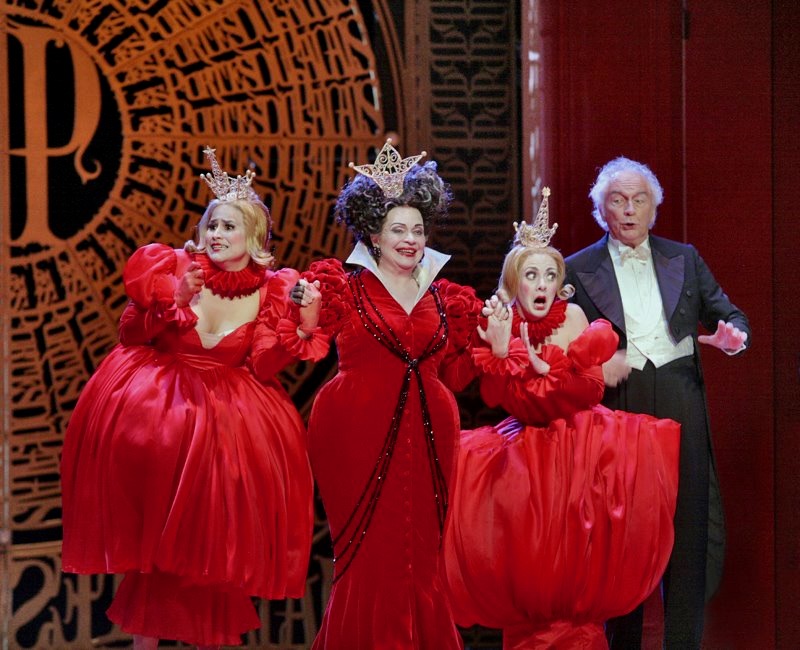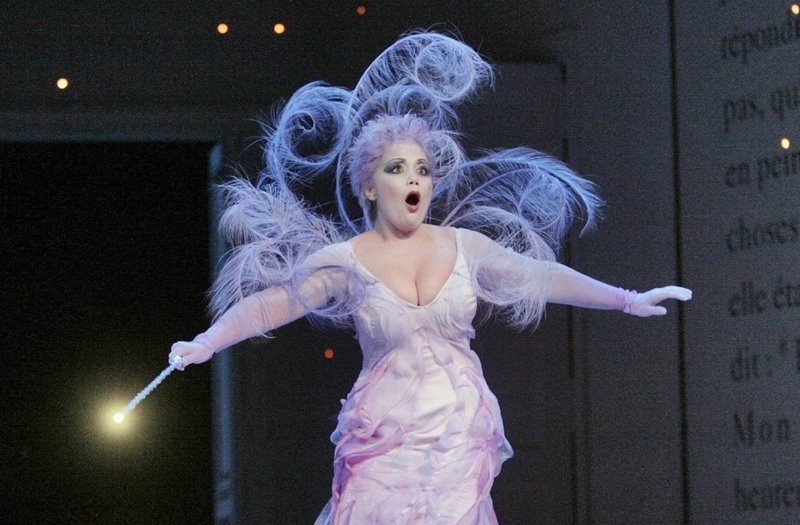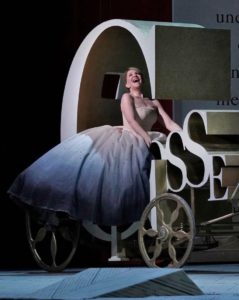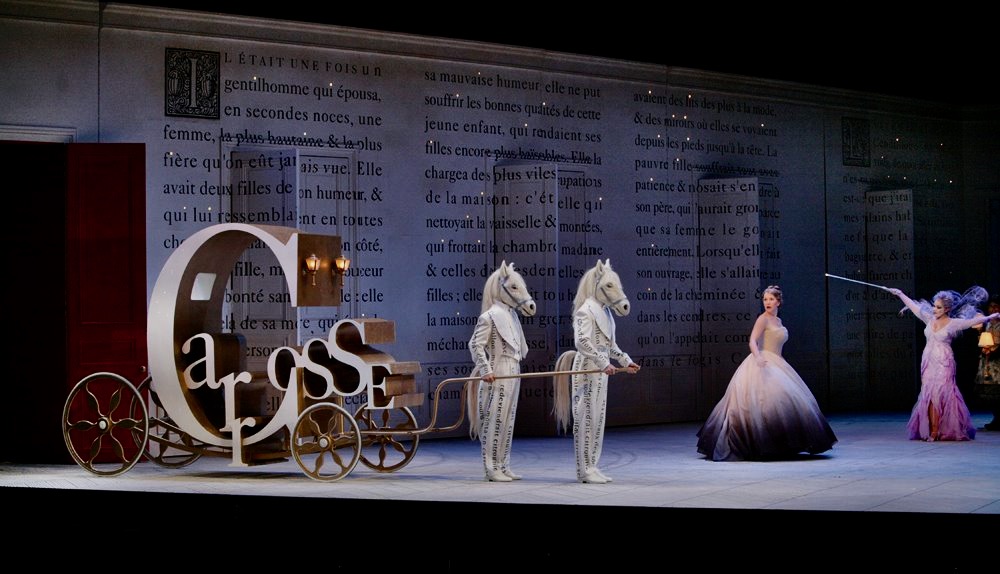Santa Fe Opera 2006 presents Massenet’s “Cendrillon”
Santa Fe Opera 2006 presents Massenet’s Cendrillon
Review by Gerald Dugan, August 18, 2006
When I first saw and heard Massenet’s Cendrillon over a generation ago, in a sparkling production at the American home of French lyric drama in general, and of Massenet in particular, the San Francisco Opera, I wondered why this piece had not entered the standard repertory. True, it had a delightful rival in Rossini’s brilliant Cenerentola, then making the rounds of the world’s best opera houses in the celebrated Ponnelle production, starring Frederica von Stade.
Rossini’s comedy cut the beloved Fairy Godmother in favor of an earthy benefactor, and eliminated the glass-slipper-gone-missing routine, substituting the less daring missing half of a missing bracelet. Nevertheless, that perhaps still epitomizes the wish-fulfillment fantasy of most women – to meet a rich, handsome young prince, who will love and remain faithful to them forever – and the Rossini opera had the crucial advantage of a real male husband-to-be, in contrast to Massenet’s trouser-role mezzo facsimile. The Rossini version also boasted a death-defying coloratura aria for its Cinderella as the finale – more satisfying than the concluding vocal display Massenet assigned to the important but secondary Fairy Godmother.
Experiencing Cendrillon again this year in Santa Fe, I was disappointed to discover that the score was no match for this composer’s Manon, Werther, or even the ineffably vulgar Thais, with its memorable solos violin “Meditation.” The music, while sometimes witty, was only occasionally inspired (particularly in the Fairy Godmother scenes, and the long duet between father and daughter). For extensive stretches – the ceremonial parade of women subsequently being unsuccessfully fitted for the glass slipper — the music was the aural equivalent of so much wallpaper: formalistic, repetitive, and trivial.
What redeemed this musical mediocrity were Laurent Pelly’s superbly farcical stage direction and his procession of outlandishly outlined, blazing red costumes (co-designed by Jean-Jacques Delmotte) festooning the women, which resembled nothing so much as a fashion runway run amok in absolutely ingenious hideousness, a kind of 19th– century Devil Wears Prada accident-in-the-making. All this was choreographed with a sense of gleeful satire puncturing all things processional, pompous and predictable, by the brilliant Laura Scozzi, who trained her gifted dancers, all the singers, chorus members, and extras to execute her intricately timed steps with such eerie, unerring accuracy that they achieved the surreal status of living caricatures, walking, singing grotesques. This was especially true in the bizarrely funny ballroom sequence, involving nearly every member of the cast – all of them crouching, lunging, gesticulating in hair-trigger unison –while performing a triumphant, riotous parody that takes the Grand Prize for Most Hilarious Opera Ballet Ever (including the animated Ponchielli “Dance of the Hours” from Disney’s Fantasia). Fortunately, the Santa Fe audience laughed so continuously and loudly during all these inspired, wonderfully staged and executed sequences that Massenet’s banalities remained largely inaudible. Never was I less inspired to shush audience members for making a ruckus during some music. In this case, the less heard, the better.
I certainly do not wish to fault the excellent Santa Fe musicians or conductor Kenneth Montgomery, who gave the best possible reading of this music, making it lively and amusing most of the time, and hoping for loud audience laughter, to turn Massenet’s sow’s ears into silk purses, the rest of the time. I still believe, despite its flaws, that Cendrillon deserves a place in the standard repertoire if only for Henri Cain’s superbly satiric rendition of the Charles Perrault original, because it gives so many intelligent singing actors such rich opportunities for broad yet witty comic display. And even if the Massenet score is merely serviceable most of the time, it does provide just enough musical highlights to allow its half-dozen principals to shine.
And shine they do, all of them, in this well-cast production. Joyce DiDonato’s rich, powerful mezzo and warm personality make her an ideal Cendrillon, modest in demeanor as the poorly dressed gaily servant, yet coming into her own when the Fairy Godmother dresses her – with the aid of numerous elves and sprites — in sumptuous white for her surprise appearance at the ball. In her duet with Prince Charming (beautifully played by the convincingly male apprentice, Jennifer Holloway, in her impressive Santa Fe debut), she shades her strong mezzo back, in order to effectively blend with Holloway’s far lighter mezzo, which suggests boyish innocence (as opposed to Octavian’s sensual experience.) DiDonato’s most moving moments, dramatically and vocally, are those with her father, the hen-pecked husband of Cendrillon’s step-mother, Pandolfe. The veteran baritone Richard Stilwell makes a superbly funny Pandolfe in a turbulent scene with his snobbish harpy of a wife (that great Dragon Lady mezzo, Judith Forst, performing an exhilarating comic variation of equally villainous and memorable Kabanicha in 2003’s Katya Kobanova) But when the time comes for this extensive , moving duet with his distraught daughter, Stilwell manages to drop his former caricature so subtly that we quickly accept his deeper humanity as a guilty father, promising his daughter that the two of them will abandon their present family and move back to a happier life in their old farm. This affecting scene, lovingly played by both DiDonato and Stilwell, is the emotional climax of the opera, giving Stilwell the courage to tell his wife and dreadful step-daughters (the hilariously full-busted comediennes, Anne-Carolyn Bird and Gabriela Garcia) to go to hell.

Gabriela Garcia as Dorothée, Judith Forst as Madame de la Haltière, Anne-Carolyn Bird as Noémie, and Richard Stilwell as Pandolfe in “Cendrillon” at Santa Fe Opera. Photo by Ken Howard.
If I have not mentioned Eglise Gutierrez’s Fairy Godmother until now, it is because I have been saving the best for last. Her radiant coloratura soprano shines like a particularly imposing diamond among so many mezzos. Fortunately, Massenet gives her the most memorable and inspired music in the score to sing, and she incarnates the magic element so essential to this fairy tale – an element noticeably missing from Rossini’s Enlightenment version of the story, which rejects the supernatural as superstition. I will never forget her summoning the coach to take Cinderella to the ball, and its fabulously sudden appearance, attached to two slender male dancers in white body stockings, sporting beautifully etched white horse heads. The coach itself, wonderfully designed by the gifted set designer Barbra Limburg, was constructed so that the elements holding the coach together spelled the word itself in French: “Carrosse,” in bright red. Ms. Gutierrez also excelled in the sequence when she magically reunited Prince Charming and Cendrillon, as well as at the end, when she blesses the union of the lovers. Massenet’s enchanting Fairy Godmother scene alone justify this work’s inclusion in the standard repertoire – as does this production, which mixes sentiment with the astringent satire of social climbing and bureaucratic toadying.
Copyright 2006 by Gerald Dugan.
New Production
Sung in French
July 15, 19, 28; August 3, 9, 18, 21, 24
The Cast
Fairy Godmother — Eglise Gutierrez
Cinderella — Joyce DiDonato
Prince Charming — Jennifer Holloway
Wicked Stepmother — Judith Forst
Pandolfe — Richard Stilwell
Dancers — Aspen Santa Fe Ballet
Conductor — Kenneth Montgomery
Director — Laurent Pelly
Scenic Designer– Barbara de Limburg
Costume Designer — Laurent Pelly
Lighting Designer — Duane Schuler
Choreographer — Laura Scozzi




I truly enjoyed this production…..the review is a bit unflattering, but you can see how successful it’s been, post Santa Fe: The Met Opera liked it enough to program it on their Live in Theaters format. I saw it again the following year in Central City Opera w/ Robin Buck. I am going to add that Eglise Gutierrez as the big chested Fairy Godmother played the part as she was quite embittered that Cendrillon missed her midnite curfew, and was hard hearted by not forgiving her for that; albeit, eventually she does, (of course.) This was such an engaging production on many levels..don’t let the negative parts of the attached review throw you off. Aside: I referenced the story about coming in after curfew in a HS sportscast I did, when an underdog visiting team arrived late after an overtime away game, after upsetting the favored home team: “I bet no wicked step parents were waiting up to give them static about arriving home late, after the upset victory.”